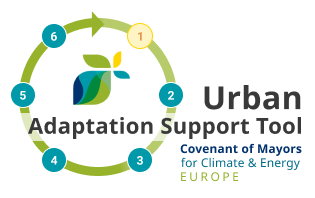
Preparing the ground for adaptation
1.2 Collecting initial information
Adaptation policy development should be based on evidence and robust information. When starting to plan for adaptation, a collection of relevant information should be undertaken. This includes identifying existing work on actual and potential future climate change-related effects, ongoing adaptation activities and good practice examples within or outside the city. To do so there is a need to team up with experts to fill in knowledge gaps or missing capacities.
The Adaptation Scoreboard in the Covenant of Mayors reporting platform MyCovenant (or the offline working version of the reporting template) helps signatory cities get an overview of where the city stands and what next steps to follow. It can serve as a good starting point and overview of what processes, structures, related data and information would be required to achieve the milestones for adaptation.
Current and future climate change impacts
When starting the process of climate change adaptation planning, a first screening of existing work on current or future possible climate change related effects in the short, medium and long term should be done. A broad first overview will help to trigger the process and develop a case for adaptation, as well as provide a basis for a more in-depth analysis at a later stage. In addition, it helps to foster the discussion on adaptation policy relevant aspects such as objectives, priority sectors, vulnerable groups, etc. There might be studies and assessments carried out for the city or the larger surrounding area, climate datasets, and statistical accounts of past weather-related natural disasters and their impacts. Several sectors/themes might be affected and sectoral analyses might have been carried out by sectoral associations, consultancies, or single public entities. The insurance sector is highly advanced at undertaking risk assessments and could be approached for cooperation. See also Step 2, as well as Chapter 2 of the EEA report Urban adaptation in Europe: how cities and towns respond to climate change, which provides an evidence based overview on climate change impacts on European cities.
The table below provides an indication of the types of information that are needed to take decisions on adaptation at the local level. The final range of information to be obtained will depend on the aims, coverage and level of detail, as well as the chosen methodologies for adaptation planning. National level data related to climate change is often centrally collected within the national climate portals and/or statistical offices. Another option is to contact organisations and institutions listed in Step 1.8.
|
Types of information |
Examples of information source |
|
Weather forecasts Observed trends Climate projections |
Daily and seasonal weather forecasts Extreme events monitoring (heat waves, cyclones, storms, floods) Modelling results of global circulation models Modelling results of regional climate and impact models Local knowledge |
|
Environmental assessments and natural hazards |
Environment agencies Resource management authorities |
|
Current vulnerability and adaptive capacity assessments |
Population, demographic and socio-economic data (e.g. from census) Health records Maps of infrastructure, green space, public health facilities |
|
Socio-economic future projections |
Population projections Spatial development plans Scenarios of political developments, consumption patterns, infrastructure development, market transformation, etc. |
|
Other relevant strategies, policies and plans |
Existing flood, storm, heat wave, drought, or other hazard plans. Strategies for: ● Sustainable/economic development ● Spatial planning ● Water and resources management ● Environmental protection |
Ongoing activities
Adaptation should not be performed in isolation. Relevant instruments and ongoing actions already in place in an urban area should be identified, such as disaster risk reduction, biodiversity protection or land use planning policies. In addition, existing national, relevant regional or sectoral adaptation strategies/plans in the country should be identified.
These guiding questions can help the adaptation team, in close cooperation with colleagues from other municipal authorities and affected stakeholders, identify ongoing activities relevant for adaptation:
- Have you ever been confronted with the topic of climate change or adaptation in your work?
- Have projects or studies on the effects of climate change been conducted on behalf of your organisation or department or are such studies planned?
- Are you aware of studies or projects on the topic of climate change or adaptation from other sources (universities, other research institutions, governmental ministries, other states, etc.) that are important for your field of work?
- Are there measures already in place that contribute to adaptation to climate change even if they are not specifically identified as adaptation measures?
- Have targeted adaptation measures already been implemented?
- Are there existing tools, strategies, processes etc. that are important or could be used for adaptation to climate change?
- What networks or initiatives relevant to adaptation are already active or could be used for adaptation?
Good practice examples
Adaptation practices that work well in one urban area can usually be transferred to tackle similar situations in other urban areas. However, the performance of individual measures may depend on the scope of the problem and the specific scale of implementation. Making use of existing information on good adaptation practices (i.e. Climate-ADAPT case studies that can be found in Step 3.2) and experiences can also optimise individual resource and effort management.
